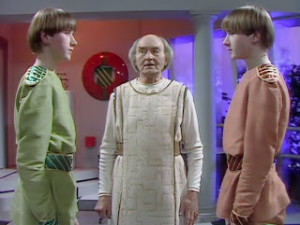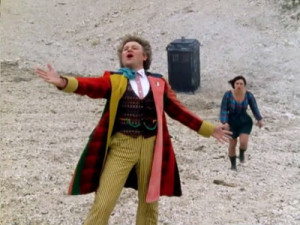 “I am the Doctor— whether you like it or not.”
“I am the Doctor— whether you like it or not.”
Story
Regeneration has left the Doctor mentally unstable, with wild mood swings from grandiose overconfidence to sudden cowardice to paranoia and outbursts of anger and violence— including a truly shocking scene when he tries to strangle Peri. Shocked at his own behavior he decides he must retire to the uninhabited asteroid Titan 3 and become a hermit. There, he and Peri encounter a space policeman in pursuit of a pair of twins kidnapped by the mysterious Professor Edgeworth. The twins are mathematical prodigies, whose genius allows them to “change events on a massive scale” (this seems to be a reference to the “block transfer computations” introduced back in Logopolis, although the term is never used). Switching gears instantly into hero mode (albeit a very melodramatic and unreliable hero), the Doctor joins the pursuit, which eventually leads to the planet Jaconda, devastated by an infestation of creatures out of Jacondan mythology: half-human, half-slug monsters who’ve turned out to be not as mythical as one would hope. The leader of these “giant gastropods” (the only name they’re given in the story) has a plan to use the twins’ mathematical genius to spread his species’ eggs across the universe, infesting every habitable planet, unless the Doctor can pull himself together long enough to stop him.
Review
Oh, dear. Oh dear. There have been times before, along the way, when Dr Who has tossed out a clunker of an episode, but it’s the sheer contrast that makes this one hurt so badly. The very same Doctor Who Magazine poll that names last week’s Caves of Androzani as the best Dr Who story ever also named The Twin Dilemma as the very worst. It wouldn’t be at the very bottom of my personal list, that demerit goes to the Fourth Doctor story Underworld, but it definitely belongs in the bottom ten.
The Twin Dilemma is a quagmire of poor plot logic, errors in judgement, badly written, badly acted, painful to watch. It scores over Underworld on my list only because it is not entirely incoherent, which Underworld was. The plot moves forward by gratuitous stupidity from characters who should know better. Right from the start, we learn that the government knows how dangerous the twins’ mathematical powers are, and the local police chief has always been afraid of what might happen if they fell into alien hands. So were there any bodyguards around them? No, of course not. The twins tell their father they’re going to “play equations” and he’s terrified by the thought of what they might accidentally do. So does he stop them? Take away their computers? At least watch to make sure nothing goes wrong? No, he sighs and goes out for the evening, leaving them to play equations, and get kidnapped, entirely unsupervised.
Professor Edgeworth is revealed to be “Azmael,” a Time Lord and old friend of the Doctor’s, who is “Master of the planet Jaconda.” What is a Time Lord (other than the Master) doing ruling over a planet that has its own population of intelligent aliens? Why’s the Doctor such good chums with a Time Lord who’d do that? And why was Azmael calling himself Edgeworth at first?
The leader of the giant gastropods, Mestor, apparently has all the Jacondans under some kind of mental domination. Or maybe he doesn’t and it just a dictator keeping power by force. Either way, once the TARDIS arrives on Jaconda, all our heroes have to do is hang around in Azmael’s office for an episode and a half before heading to the throne room where Mestor happily takes his turn carrying the Idiot Ball and conveniently destroys himself by trying to do something he had no reason to do. The word “anticlimax” gives the ending of the story too much credit.
The real crime is that an episode like this gets trotted out as the introduction to the new Doctor. Sadly, it foreshadows what things will be like over Colin Baker’s entire run on the program. If the first three seasons of Tom Baker’s run were Dr Who’s golden age, an unbroken run of outstanding stories, the coming couple of seasons are the program’s dark age. We’re heading into the era that will cause the end of the Classic series: although the quality will pick up again during the Seventh Doctor’s time on the program, by then it will be too late because only the dedicated fans will still be watching. But I’m getting ahead of myself.
 The New Doctor
The New Doctor
Given better writing, and a better story to play against, the Doctor’s arc in this story could have been an intriguing twist on the regeneration story. In the previous examples, we’ve seen the Doctor physically weakened after the trauma of regeneration, taking anywhere from one episode up to a full story to recover. For the Sixth Doctor, the production changes things by making him emotionally weakened and unstable. Colin Baker manages to play it fairly well, and the more comical scenes of the Doctor’s wild behavior give us the few bright spots in this story. In between his manic episodes, we get glimpses of the Doctor we’ve always known, and there’s a running thread to all his “fits” that starts to give us clues as to what spin this new persona will put on the character. As always in the program’s history, the new Doctor is a complete contrast to his predecessor: where the Fifth Doctor was quiet and self-effacing, the Sixth is grandiose, bombastic and arrogant. Even in the midst of his mood swings, whether he’s being heroic or cowardly he does so with melodramatic excess.
And of course, the costume reflects the character: from the Fifth Doctor’s mild shades-of-beige, we change to the “explosion in a rainbow factory” as Colin Baker calls it. The multi-colored costume was not Colin Baker’s idea: he actually proposed a costume all in black, with a long leather coat (it would have looked a lot like what Christopher Eccleston wore as the Ninth Doctor in the new series). John Nathan-Turner had other ideas. JN-T went to the costume designer and said his impression had always been that the Doctor had no taste (as least as humans perceive it) and asked her to design a tasteless costume. Unhappy with the idea, she grabbed some random colored pencils and scrawled them all over an outline of a coat, then took that to JN-T intending to show him what a bad idea it was. Instead he said “That’s perfect! Do that!” And so we’re stuck with it.
Details
- Script editor Eric Saward had long wanted the Doctor to be more of an action hero, and not in the gentlemanly way that Jon Pertwee was with his “Venusian aikido.” Recall that a recurring feature of his scripts during the Peter Davison years is the Doctor picking up, and using, a gun. But Davison’s persona was already established. Now given a chance to be in on the design of a new Doctor, he took the chance to design a character who would be the kind of violent action hero he wanted, and we’ll be seeing that more and more in the coming season.
- Saward knew that the Doctor couldn’t be like that for the long term. At the end of The Twin Dilemma it’s still not clear whether the new Doctor has really stabilized or not, and this was deliberate. Saward and JN-T had conceived the idea of a character arc in which the turmoil of the regeneration left the Doctor in a darker and more violent state, from which he would only gradually, over several seasons, find his way back to his “true” self. Unfortunately, outside events would prevent them from realizing their plans.
- Fans never want to blame the Doctor when things go wrong in the series, and in this case we have good evidence to exonerate Colin Baker from any responsibility for becoming “the Doctor that fans don’t like.” Baker has been a frequent contributor to the Big Finish line of audio dramas, producing a considerable series of Sixth Doctor adventures, and they’ve given him a chance to show just how good his abrasive, arrogant version of the Doctor could have been if given better stories to play in. Colin Baker’s audio adventures are generally praised.
- It tells you something that in the Big Finish dramas, even though they’re audio dramas, they actually changed the Sixth Doctor’s costume. It’s only for the cover art of the CDs, but still: they gave him a version of his TV costume all in shades of blue, which manages to still capture the garish nature of the character himself without being quite so cringe-inducing.
- The Twin Dilemma was the last story of season 21. When season 22 begins, a huge change for the program will come in with it— after being broadcast in 22.5 minute episodes ever since its premiere in 1963, Dr Who would switch to 45-minute episodes. Season 22 was going to consist of 13 45-minute episodes, which works out to the same amount of airtime as the 26 22.5-minute episodes of the last few seasons. More on the reason for the change, and what it would mean, next time.
Next Week:
“Attack of the Cybermen,” 2 (45-minute) episodes, the season 22 premiere

